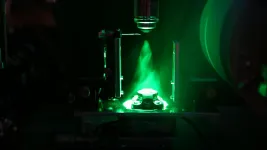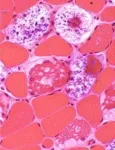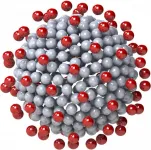New nanoscale device for spin technology
Spin waves could unlock the next generation of computer technology, a new component allows physicists to control them
2021-04-16
(Press-News.org) Researchers at Aalto University have developed a new device for spintronics. The results have been published in the journal Nature Communications, and mark a step towards the goal of using spintronics to make computer chips and devices for data processing and communication technology that are small and powerful.
Traditional electronics uses electrical charge to carry out computations that power most of our day-to-day technology. However, engineers are unable to make electronics do calculations faster, as moving charge creates heat, and we're at the limits of how small and fast chips can get before overheating. Because electronics can't be made smaller, there are concerns that computers won't be able to get more powerful and cheaper at the same rate they have been for the past 7 decades. This is where spintronics comes in.
"Spin" is a property of particles like electrons in the same way that "charge" is. Researchers are excited about using spin to carry out computations because it avoids the heating issues of current computer chips. 'If you use spin waves, it's transfer of spin, you don't move charge, so you don't create heating,' says Professor Sebastiaan van Dijken, who leads the group that wrote the paper.
Nanoscale magnetic materials
The device the team made is a Fabry-Pérot resonator, a well known tool in optics for creating beams of light with a tightly controlled wavelength. The spin-wave version made by the researchers in this work allows them to control and filter waves of spin in devices that are only a few hundreds of nanometres across.
The devices were made by sandwiching very thin layers of materials with exotic magnetic properties on top of eachother. This created a device where the spin waves in the material would be trapped and cancelled out if they weren't of the desired frequency. 'The concept is new, but easy to implement,' explains Dr Huajun Qin, the first author of the paper, 'the trick is to make good quality materials, which we have here at Aalto. The fact that it is not challenging to make these devices means we have lots of opportunities for new exciting work.'
Wireless data processing and analogue computing
The issues with speeding up electronics goes beyond overheating, they also cause complications in wireless transmission, as wireless signals need to be converted from their higher frequencies down to frequencies that electronic circuits can manage. This conversion slows the process down, and requires energy. Spin wave chips are able to operate at the microwave frequencies used in mobile phone and wifi signals, which means that there is a lot of potential for them to be used in even faster and more reliable wireless communication technologies in the future.
Furthermore, spin waves can be used to do computing in ways that are faster that electronic computing at specific tasks 'Electronic computing uses "Boolean" or Binary logic to do calculations,' explains Professor van Dijken, 'with spin waves, the information is carried in the amplitude of the wave, which allows for more analogue style computing. This means that it could be very useful for specific tasks like image processing, or pattern recognition. The great thing about our system is that the size structure of it means that it should be easy to integrate into existing technology'
Now that the team has the resonator to filter and control the spin waves, the next steps are to make a complete circuit for them. "To build a magnetic circuit, we need to be able to guide the spin waves towards functional components, like the way conducting electrical channels do on electronic microchips. We are looking at making similar structures to steer spin waves" explains Dr Qin.
INFORMATION:
More Information
The paper Nanoscale magnonic Fabry-Pérot resonator for low-loss spin-wave manipulation is published in Nature Communications. https://doi.org/10.1038/s41467-021-22520-6 It was supported by the Academy of Finland and the German Research Foundation. Device fabrication was carried out at OtaNano.
Contact Details
Prof. Sebastiaan van Dijken
E-mail: sebastiaan.van.dijken@aalto.fi
Phone: +358-50-3160969
Website: http://physics.aalto.fi/groups/nanospin/
Dr Huajun Qin
E-mail: huajun.qin@aalto.fi
[Attachments] See images for this press release:

ELSE PRESS RELEASES FROM THIS DATE:
2021-04-16
Vitamin D deficiency may impair muscle function due to a reduction in energy production in the muscles, according to a mouse study published in the Journal of Endocrinology. Vitamin D deficient mice were found to have impaired muscle mitochondrial function, which may have implications for muscle function, performance and recovery. This may suggest that preventing vitamin D deficiency in older adults could help maintain better muscle strength and function and reduce age related muscle deterioration, but further studies are needed to confirm this.
Vitamin D is a hormone well known to be important for maintaining bone health and preventing ...
2021-04-16
Douglas Wilbur '14, a visiting Ph.D. scholar in the Department of Communication at UTSA, has published a study that shows how researchers can craft message campaigns to protect individuals from adopting extremist views.
According to his research, when people are explicitly told that they are free to accept or reject propagandistic claims, the likelihood of choosing a moderate view increases. This was a result of a survey of attitudes that tested counter-propaganda strategies, which stressed a person's autonomy, and then measured sentiments after exposure.
The study was ...
2021-04-16
Sophia Antipolis - 16 April 2021: Working hours that deviate from an individual's natural body clock are associated with greater cardiovascular risk, according to research presented at ESC Preventive Cardiology 2021, an online scientific congress of the European Society of Cardiology (ESC).1
"Our study found that for each hour the work schedule was out of sync with an employee's body clock, the risk of heart disease got worse," said study author Dr. Sara Gamboa Madeira of the University of Lisbon, Portugal.
At least 20% of European employees work atypical hours or shifts,2 and growing scientific evidence associates these with deleterious cardiovascular outcomes.3 A number of explanations ...
2021-04-16
Rare diseases are sometimes the most difficult to treat because of a lack of research and fewer participants to study.
An example would be those who have Pompe disease, a genetic condition when a body can't make a protein that breaks down a complex sugar, called glycogen, for energy. Too much glycogen builds up and damages muscles and organs. The disease causes muscle weakness and trouble breathing and can affect the heart and muscles.
In the case of Pompe disease, however, University of Cincinnati researchers have found a newer, more effective treatment for the rare condition that could become the new standard of care.
Hani Kushlaf, MD, an associate professor in both the Department of Neurology and Rehabilitation Medicine and the ...
2021-04-16
COVID-19 needs no introduction. Last year, the disease, which is caused by the virus SARS-CoV-2, reached every continent across the globe. By the end of March 2021, there had been an estimated 128 million cases recorded with almost three million of these being fatal. As scientists' race to develop vaccines and politicians coordinate their distribution, fundamental research on what makes this virus so successful is also being carried out.
Within the Mathematics, Mechanics, and Materials Unit at the Okinawa Institute of Science and Technology Graduate University (OIST), postdoctoral researcher, Dr. Vikash Chaurasia, and Professor Eliot Fried have been using energy minimization techniques to look at charged proteins on biological particles. Previously they researched ...
2021-04-16
Researchers from University of British Columbia, Emory University, and New York University published a new paper in the Journal of Marketing that investigates the relationship between branding and counter-marketing in the cigarette industry.
The study, forthcoming in the Journal of Marketing, is titled "Investigating the Effects of Excise Taxes, Public Usage Restrictions, and Anti-Smoking Ads across Cigarette Brands" and is authored by Yanwen Wang, Michael Lewis, and Vishal Singh.
While the goal of marketing is usually to boost purchase rates and strengthen relationships between consumers and brands, counter-marketing is an increasingly common strategy for reducing the consumption of "vice" goods such as cigarettes. Counter-marketing activities may ...
2021-04-16
A past COVID-19 infection does not completely protect against reinfection in young people, according to an observational study of more than 3,000 healthy members of the US Marines Corps most of whom were aged 18-20 years, published in The Lancet Respiratory Medicine journal.
The authors say that despite previous infection and the presence of antibodies, vaccination is still necessary to boost immune responses, prevent reinfection, reduce transmission, and that young people should take up the vaccine wherever possible.
In the study, between May and November 2020, around 10% (19 out of 189) of participants who were previously infected with SARS-CoV-2 (seropositive) became reinfected, compared with new infections in 50% (1,079 out of 2,247) ...
2021-04-16
There is consistent, strong evidence that the SARS-CoV-2 virus, which causes COVID-19, is predominantly transmitted through the air, according to a new assessment published today in the medical journal Lancet. Therefore, public health measures that fail to treat the virus as predominantly airborne leave people unprotected and allow the virus to spread, according to six experts from the UK, USA and Canada, including Jose-Luis Jimenez, chemist at the Cooperative Institute for Research in Environmental Sciences (CIRES) and University of Colorado Boulder.
"The evidence supporting airborne transmission is overwhelming, and evidence supporting large droplet transmission is almost ...
2021-04-15
Neurological disorders are the number one cause of disability in the world, leading to seven million deaths each year. Yet few treatments exist for these diseases, which progressively diminish a person's ability to move and think.
Now, a new study suggests that some of these neurological disorders share a common underlying thread. Staufen1, a protein that accumulates in the brains of patients with certain neurological conditions, is linked to amyotrophic lateral sclerosis (ALS), or Lou Gehrig's disease, along with other neurological disorders, including Alzheimer's, Parkinson's, and Huntington's disease, according to University of Utah Health scientists.
The findings connect Staufen1 ...
2021-04-15
ITHACA, N.Y. - Since state austerity policies initiated a potable water crisis seven years ago in Flint, Michigan, public health monitoring has focused on potential developmental deficits associated with lead exposure in adolescents or fetuses exposed in utero.
New research from Cornell and the University of Michigan offers the first comprehensive evidence that the city's adult residents suffered a range of adverse physical and mental health symptoms potentially linked to the crisis in the years during and following it, with Black residents affected disproportionately.
In a survey of more than 300 residents, 10% reported having been diagnosed by a clinician with elevated ...
LAST 30 PRESS RELEASES:
[Press-News.org] New nanoscale device for spin technology
Spin waves could unlock the next generation of computer technology, a new component allows physicists to control them


